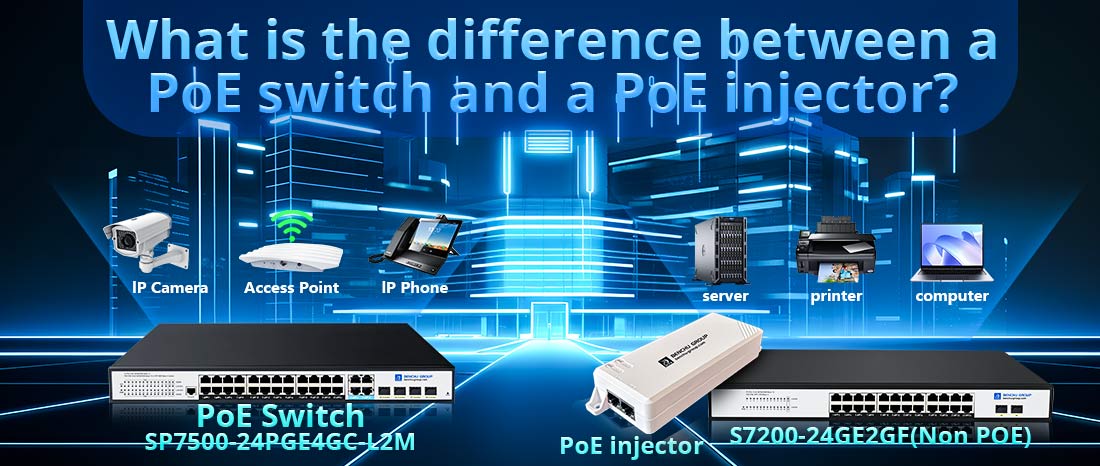
The difference between a PoE switch and a PoE injector lies in how they deliver Power over Ethernet (PoE) to connected devices, their use cases, and the network infrastructure they support. Here’s a detailed breakdown of each:
1. PoE Switch
A PoE switch is a network switch that has PoE capabilities built into its Ethernet ports. This means it can supply both power and data to connected devices, such as IP cameras, VoIP phones, and wireless access points, over a single Ethernet cable.
Key Features of a PoE Switch:
Integrated Power and Data: Each PoE port on the switch can deliver both power and data to connected PoE-compatible devices.
Multiple PoE Ports: PoE switches typically have multiple PoE-enabled ports (e.g., 8, 16, 24, or 48 ports), allowing them to power many devices simultaneously.
Managed vs. Unmanaged: PoE switches can be either managed (allowing for remote control, monitoring, and configuration) or unmanaged (no advanced features, simple plug-and-play functionality).
PoE Power Budget: PoE switches have a total power budget, which is the maximum amount of power the switch can provide across all PoE ports. This must be enough to support all connected devices.
Power Standards:
--- PoE (IEEE 802.3af): Provides up to 15.4W per port.
--- PoE+ (IEEE 802.3at): Provides up to 30W per port.
--- PoE++ (IEEE 802.3bt): Provides up to 60W or 100W per port for higher-power devices.
When to Use a PoE Switch:
--- When you need to power multiple PoE devices across a network.
--- In larger networks where centralized management and scalability are important.
--- When building a new PoE network or upgrading an existing one to support PoE devices.
Advantages of a PoE Switch:
--- Scalability: Can power many devices at once.
--- Simplifies Infrastructure: Reduces the need for separate power supplies or injectors for each device.
--- Centralized Power Management: In managed PoE switches, power allocation and monitoring can be controlled remotely.
2. PoE Injector
A PoE injector is a device that adds PoE capabilities to a non-PoE network. It injects power into an Ethernet cable carrying data from a regular (non-PoE) switch, router, or hub, allowing it to power a PoE-enabled device.
Key Features of a PoE Injector:
--- Single-Port Power Injection: Typically used to provide PoE to one device at a time. There are also multi-port injectors, but they are less common.
--- Simple Setup: The injector is placed between the non-PoE switch and the PoE device. It receives data from the switch and adds power to the Ethernet cable.
--- Standalone Device: It operates independently of your network switch, meaning you don’t need to replace your existing switch to add PoE capabilities.
--- Power Standards: PoE injectors are available for PoE (802.3af), PoE+ (802.3at), and PoE++ (802.3bt) to support varying power requirements.
When to Use a PoE Injector:
--- When you have a non-PoE switch and need to power a few PoE devices without replacing your switch.
--- For small networks or individual devices, such as powering a single IP camera or access point.
--- In cases where only a few PoE devices are needed, making a PoE switch unnecessary or cost-prohibitive.
Advantages of a PoE Injector:
--- Cost-Effective: Allows you to add PoE capabilities to an existing network without replacing your switch.
--- Simple to Deploy: Easy to add to a network, especially for one-off PoE devices.
--- No Network Impact: The injector only affects the device it is powering, leaving the rest of the network unaffected.
Comparison: PoE Switch vs. PoE Injector
| Feature | PoE Switch | PoE Injector |
| Functionality | Combines both power and data in one device. | Adds power to a single Ethernet connection. |
| Number of Devices | Powers multiple PoE devices simultaneously. | Typically powers one device per injector. |
| Scalability | Ideal for larger networks with many devices. | Suitable for smaller networks or individual devices. |
| Network Role | Replaces a regular switch, handles all traffic and PoE. | Works alongside a non-PoE switch. |
| Power Budget | Shared power budget for all ports. | Dedicated power for one device. |
| Cost | Higher upfront cost for multiple devices. | Lower cost, especially for small networks. |
| Use Case | Large networks with many PoE devices. | Single or few PoE devices on a non-PoE network. |
Summary
Single or few PoE devices on a non-PoE network.A PoE switch is a multi-port network switch with PoE capabilities built-in, suitable for powering multiple devices in medium to large networks.
Single or few PoE devices on a non-PoE network.A PoE injector is a standalone device that adds PoE functionality to individual Ethernet connections, ideal for small setups or when only a few PoE devices need power.
For larger networks or future-proofing, a PoE switch is often the better choice. For smaller deployments or when upgrading an existing non-PoE network without replacing the switch, a PoE injector offers a simple and cost-effective solution.